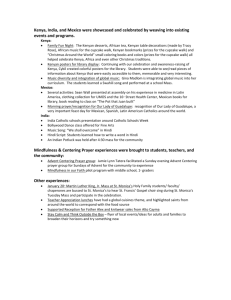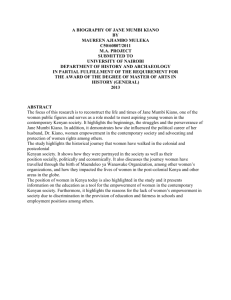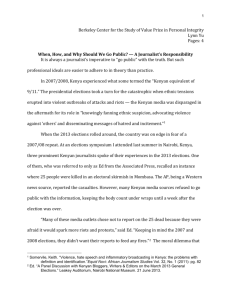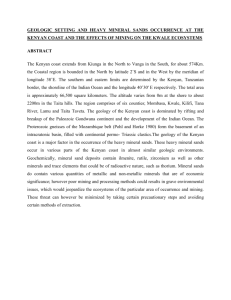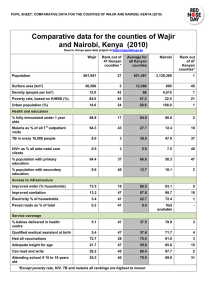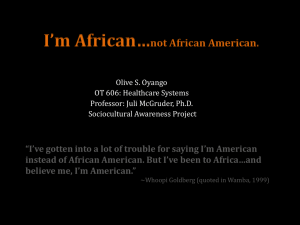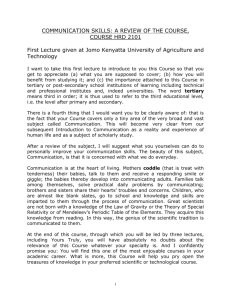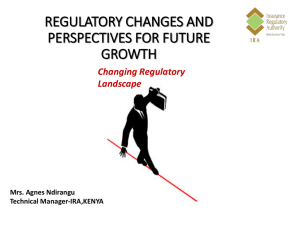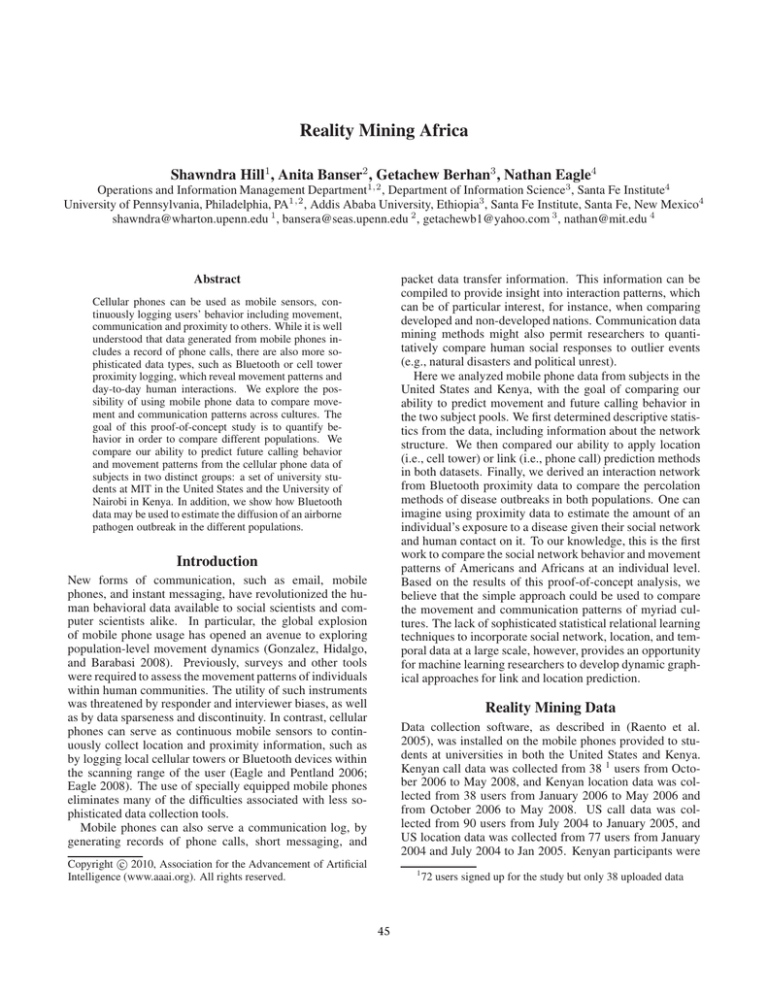
Reality Mining Africa
Shawndra Hill1, Anita Banser2 , Getachew Berhan3 , Nathan Eagle4
Operations and Information Management Department1,2 , Department of Information Science3 , Santa Fe Institute4
University of Pennsylvania, Philadelphia, PA1,2 , Addis Ababa University, Ethiopia3, Santa Fe Institute, Santa Fe, New Mexico4
shawndra@wharton.upenn.edu 1 , bansera@seas.upenn.edu 2 , getachewb1@yahoo.com 3 , nathan@mit.edu 4
packet data transfer information. This information can be
compiled to provide insight into interaction patterns, which
can be of particular interest, for instance, when comparing
developed and non-developed nations. Communication data
mining methods might also permit researchers to quantitatively compare human social responses to outlier events
(e.g., natural disasters and political unrest).
Here we analyzed mobile phone data from subjects in the
United States and Kenya, with the goal of comparing our
ability to predict movement and future calling behavior in
the two subject pools. We first determined descriptive statistics from the data, including information about the network
structure. We then compared our ability to apply location
(i.e., cell tower) or link (i.e., phone call) prediction methods
in both datasets. Finally, we derived an interaction network
from Bluetooth proximity data to compare the percolation
methods of disease outbreaks in both populations. One can
imagine using proximity data to estimate the amount of an
individual’s exposure to a disease given their social network
and human contact on it. To our knowledge, this is the first
work to compare the social network behavior and movement
patterns of Americans and Africans at an individual level.
Based on the results of this proof-of-concept analysis, we
believe that the simple approach could be used to compare
the movement and communication patterns of myriad cultures. The lack of sophisticated statistical relational learning
techniques to incorporate social network, location, and temporal data at a large scale, however, provides an opportunity
for machine learning researchers to develop dynamic graphical approaches for link and location prediction.
Abstract
Cellular phones can be used as mobile sensors, continuously logging users’ behavior including movement,
communication and proximity to others. While it is well
understood that data generated from mobile phones includes a record of phone calls, there are also more sophisticated data types, such as Bluetooth or cell tower
proximity logging, which reveal movement patterns and
day-to-day human interactions. We explore the possibility of using mobile phone data to compare movement and communication patterns across cultures. The
goal of this proof-of-concept study is to quantify behavior in order to compare different populations. We
compare our ability to predict future calling behavior
and movement patterns from the cellular phone data of
subjects in two distinct groups: a set of university students at MIT in the United States and the University of
Nairobi in Kenya. In addition, we show how Bluetooth
data may be used to estimate the diffusion of an airborne
pathogen outbreak in the different populations.
Introduction
New forms of communication, such as email, mobile
phones, and instant messaging, have revolutionized the human behavioral data available to social scientists and computer scientists alike. In particular, the global explosion
of mobile phone usage has opened an avenue to exploring
population-level movement dynamics (Gonzalez, Hidalgo,
and Barabasi 2008). Previously, surveys and other tools
were required to assess the movement patterns of individuals
within human communities. The utility of such instruments
was threatened by responder and interviewer biases, as well
as by data sparseness and discontinuity. In contrast, cellular
phones can serve as continuous mobile sensors to continuously collect location and proximity information, such as
by logging local cellular towers or Bluetooth devices within
the scanning range of the user (Eagle and Pentland 2006;
Eagle 2008). The use of specially equipped mobile phones
eliminates many of the difficulties associated with less sophisticated data collection tools.
Mobile phones can also serve a communication log, by
generating records of phone calls, short messaging, and
Reality Mining Data
Data collection software, as described in (Raento et al.
2005), was installed on the mobile phones provided to students at universities in both the United States and Kenya.
Kenyan call data was collected from 38 1 users from October 2006 to May 2008, and Kenyan location data was collected from 38 users from January 2006 to May 2006 and
from October 2006 to May 2008. US call data was collected from 90 users from July 2004 to January 2005, and
US location data was collected from 77 users from January
2004 and July 2004 to Jan 2005. Kenyan participants were
c 2010, Association for the Advancement of Artificial
Copyright Intelligence (www.aaai.org). All rights reserved.
1
45
72 users signed up for the study but only 38 uploaded data
This method was chosen because most subjects are students
therefore likely work at the same location. We then identified the top 8 towers that showed up for individual users
during the work hours and labeled them Work. In addition to labeling all group level work towers as Work, we
also labeled the individual level user-tower ID pairs that
showed up in the top 8 towers from above as Work. Individual ’Home’ towers were identified as the top 8 towers
that showed up for individuals from 0200-0400 (Sunday to
Sunday), based on the assumption that most users were at
home during these hours. User-tower ID pairs that were not
already labeled Work were also labeled Home. All other unlabeled user-tower ID pairs were labeled ’Other’. To label
each hour of a given day, we used a maximum vote method:
That is, for every hour, we labeled the location by taking the
most frequent label in that hour. We labeled hours for which
there were no registered tower location data as ’No Signal’
hours. The towers or locations learned in one time period
were used to predict locations in another. We built a decision tree model to predict user location conditioned on the
hour of day and day of the week. In addition to the decision tree model, we used Shannon entropy to quantify and
compare movement behavior:
second-year computer science students at the University of
Nairobi. US subjects were students at MIT. All data were
anonymized to ensure the privacy of participants.
Call log details collected from the phones included the
following data for each communication: the type of communication (voice call, text message, packet data, etc.), the
unique user ID of the cell phone user and that of the person with whom the user communicated, and the timestamp
(start, end, and duration times) of the communication. Cell
tower proximity log details included the unique user ID of
the cell phone user, the timestamp at which the data was collected, and the ID of the cell towers within the cell phone’s
detectable range. Likewise, Bluetooth proximity log details
included the Bluetooth IDs of users who were close at a
given timestamp. These three types of data, call details, cell
tower locations, and Bluetooth IDs, were used to construct
networks of interactions.
Methods
Predicting Call Links
People can be identified by the people they call (Hill et al.
2006). However, the extent to which this is true relies on
limited change to an individual’s calling circle. To quantify
this change, we calculated the amount of overlap in friends’
links from month to month for US and Kenyan users using
the Dice similarity score (Dice 1945):
H(X) = −
n
p(xi )logb p(xi ),
(2)
i=1
We approached the entropy calculation as a four class problem, where b is set to 4, and p(xi ) is the probability of person
i being at Home, Work, or Other or having No Signal.
2|A ∩ B|
D(A, B) =
,
(1)
|A| + |B|
where A is the set of links in time period one (the training
period), and B is the set of links in time period two (the test
period). In this way, we observed how well the links in the
training period correspond to those in the test period. The
Dice criterion is bounded between 0 and 1, with a value of
1 when the sets are identical and 0 when there is no overlap.
In addition to the Dice criterion, we used the absolute score
determined as the number of call link overlaps from month
to month. For example, for November-December 2004, the
overlap score per user is the number of people called by a
user in both November and December. We applied this technique across multiple months to avoid sensitivity to the test
period.
Predicting Potential Disease Transmission
The Bluetooth data enabled us to construct interaction networks of subjects. Two users form a link when they are in
close proximity to one another. These data may be useful in
predicting the spread of a virus. There has been recent work
linking wireless network data to virus propagation (Khayam
and Radha 2005; Zheng, Li, and Gao 2006). However, the
focus is typically on software viruses and not communicable
diseases. We apply a well-discussed epidemiology theory
of disease transmission, the Susceptible-Immune-Recovery
model, where subjects are assumed a level of susceptibility,
immunity, and ability to recover (Hethcote 1976). We used
the publicly available software sispread (Alvarez et al. 2010)
to simulate outbreaks on our Bluetooth network.
Predicting Location
By logging timestamped cell tower locations, we were able
to construct individual movement models. Our goal was
to predict whether the user was at home, work, or somewhere else at a given time. We chose to examine data from
the month of October (Kenya: October 2007; US: October 2004) because it falls during the school semester (and
thus students are expected to be at school) and because October does not have any holidays, which might cause deviation from ’normal’ cell phone user behavior. We inferred user location (i.e., home, work, other, or no signal)
based on the visible tower(s):. ’work’ towers were identified that were registered by > 20% of users’ cell phones
during October 2004 (US) or October 2007 (Kenya) during
customary working hours (0900-1700, Monday to Friday).
Results
Descriptive Statistics
Location and call data from US and Kenyan users were compared using visualization and descriptive statistics of their
social network including degree distribution and clustering
coefficient. We plotted trends by the time of day for the different communication types (i.e., voice call, short message,
or packet data) for both Kenyan and US data.
In terms of communication method, US users sent
markedly more packet data messages than Kenyan users, and
Kenyan users made more voice calls than US users. There
was no significant difference in short messaging use (Fig. 1).
46
80
200
US
Kenya
40
0
20
Percentage of Total Use
60
Average Duration Per Voice Call
50
100
150
US
Kenya
Short Message
Voice Call
0
Packet Data
0
Mobile Phone Usage Type
5
10
15
20
Hour
Figure 3: Average mobile phone call duration according to
the hour of day for US and Kenyan users
These results may indicate that fewer Kenyan users utilized
or had access to packet data mobile phone plans, which is
consistent with Kenya’s being a less-developed nation than
the United States. The Kenyan data displayed a marked difference between the average number of voice calls and average number of unique voice calls (data not shown), and US
users consistently made fewer and longer voice calls than
Kenyan users (Figs. 2 and 3, P < 0.0001). While US users
exhibited a peak in call duration in the mornings at approximatly 0800, the call duration for Kenyan users remained
relatively constant (Fig. 3). The duration of packet data
calls (downloads) was also significantly higher in the United
States.
These data may suggest that dropped calls and/or poor
signaling were more common among Kenyan users, potentially suggesting a poorer quality of service overall or a
sparser cell tower distribution (although the tower distribution in Nairobi is reportedly similar to the distribution in
Boston). Alternatively, the increased number of ”missed
calls” may indicate a difference in economic development
between the two user populations (Fig. 4). Mobile phone
users residing in low-income areas frequently use ”missed
calls” to relay a message. For example, a cell phone user
may purposefully place a ”missed call” to indicate that he
or she has returned home safely, thus relaying a predetermined message without using airtime. Outbound calls
from Kenyan users were either missed or had zero duration
62.01% of the time compared to 31.8% US .
While most US voice calls were made in the evenings (after 1700), Kenyan users had the highest mobile phone usage
during work hours (Fig. 5), suggesting differences between
the work cultures of the two countries or that different types
of calls (work-related vs. personal calls) were made at different times of day. The call duration also varied depending
on the day of the week in both the United States and Kenya.
For US users, the call duration peaked on Wednesday and
Thursday at 1000 and 2300. For Kenyan users, call duration
peaked on Tuesday at 1400 (data not shown).
Figure 6 shows the distribution of unique towers seen by
Kenyan and US users as a function of time, which can serve
as a proxy for general movement. Together with the other
data, this figure suggests that while the movement patterns
of US and Kenyan users were similar, their overall call patterns were not.
The Kenyan and US user within-subject networks were
relatively similar with respect to degree distribution (Fig.
7). This result indicated that each Kenyan/US user called
the same number of people as other Kenyan/US users (on
50
1000
Figure 1: Communication types for US and Kenyan mobile
phone users
US
Kenya
30
40
0
0
10
20
Percentage of Outgoing Calls
600
400
200
Average Duration in Seconds
800
US
Kenya
Packet Data
Missed Calls
Voice Call
Calls with Zero Duration
Type of Mobile Phone Usage
Figure 4: Percentage of all outgoing calls that are either
missed or have zero call duration
Figure 2: Mobile phone call/download durations for Kenyan
and US users.
47
25
80
US
Kenya
0
0
5
20
Frequency
40
Percentage Frequency
10
15
60
20
US
Kenya
5
10
15
0
20
50
100
Hour
Figure 5: Distribution of total voice calls per person according to hour of day. Data are for July 04-Nov 04 (US) or July
07-Nov 07 (Kenya). Similar distributions were observed for
short messages.
250
300
350
Figure 7: Degree distributions for voice calls for US and
Kenyan users. Data are for Jul 04 - Jan 05 (US) and Jul 07 Jan 08 (Kenyan).
utes communicated with during the first month), the Kenyan
group was less stable by Dice score (Fig. 9).
average). Furthermore, phone call network plots (Fig. 8) indicated that users within both the US and Kenya were highly
clustered with their colleagues.
Predicting Location
We next assessed how well we could predict ’place’ of a
subject at any given time in our dataset. The attributes in
our model were the day of the week and hour of the day,
and the target was the place (Home, Work or Other) where
the user was found. Our predictive models were evaluated
based on their ability to rank individuals according to different attribute subsets. We used the area under the ROC curve
(AUC) to compare models.
The average AUC scores for Home, Work, and Other for
US and Kenyan users are shown in Table 1. It was relatively
easier to predict Home than Work or Other locations. We
also observed a large relative difference in AUC in our ability to predict Home compared to Work for Kenyan subjects suggesting home life is much more stable (users arrive home
at a certain hour and stay there).
Finally, we calculated the average entropy per hour for the
subjects in the two countries. The tower locations (Home,
Work, Other, or No Signal) recorded by US or Kenyan users
in October 2004 or October 2007, respectively, were monitored over the course of 7 consecutive days (168 h of loca-
Predicting Call Links
Because the call data was very sparse, to compare call behavior across two months, we isolated the months for which
Kenyan and US data had > 75% of users making calls
in two consecutive months. These ’overlap months’ were
November and December 2004 (United States) and November and December 2006 (Kenya). However, we applied our
approach to all possible month pairs in our dataset.
In Figure 9, we plotted data using both the Dice coefficient score and absolute overlap score (number of friends
in common). Dice score distribution plots indicate the selfsimilarity of users called when each person in one month
is compared to themselves in the next month. A higher
mean suggests that people are more ”stable” in whom they
call, while a lower mean suggests less ”stability” (i.e., more
change in behavior from month to month). Based on all calls
and calls for the top 10 friends (ranked by number of min120
150
200
Degree
0
20
40
Frequency
60
80
100
US
Kenya
5
10
15
20
Hour
Figure 8: Within subject phone call links among Kenyan
(left) and US (right) mobile phone users. Kenyan: 30 nodes,
cc = 0.40; US: 73 nodes, cc = 0.23
Figure 6: Distribution of the total number of towers seen by
US and Kenyan users using the entire dataset.
48
40
S_Kenya
I_Kenya
R_Kenya
S_US
I_US
R_US
0
40
30
20
0
10
10
Number of People
Percentage Frequency
20
30
50
60
US
Kenya
0.0
0.2
0.4
0.6
Dice Score
0.8
0
1.0
Home
Work
Other
10
15
20
Time
Figure 9: Dice coefficient plot showing the overlap score
distribution for US and Kenyan users. Links between friends
were established using both voice calls and short messages
and then ranked by the number of minutes on the links to get
the top 10 friends for comparison.
US
0.598
0.579
0.538
5
Figure 10: Number of estimated susceptible (S), infected (I) and recovered (R) people when incorporating the
weights/number of Bluetooth interactions
viduals at each time point. The Kenyan Bluetooth network
was constructed with information gathered over 561 days,
while the US Bluetooth network was constructed with information gathered over 300 days. Because of this, the number of in-network interactions, represented as edge weights,
in the Kenyan Bluetooth network was disproportionately
higher than that in the US network. To directly compare
the networks, we normalized (multiplied) the Kenyan edge
weights by the ratio 300/561. Before the workshop presentation, we intend to apply a weighted SIR network that also
accounts for timestamps, rather than assuming everyone has
an interaction at each time point.
Kenya
0.684
0.629
0.532
Table 1: Average AUC for Home, Work, and Other Cell towers for US and Kenyan subjects
tion data). This process revealed entropies for Kenyan and
US users of 1.32 and 1.519, respectively. These data indicate increased movement among US users, as compared to
Kenyan users. It should be noted that the sample size for
Kenyan users was very small (9 active Kenyan vs. 55 active
US subjects).
Changes with Outlier Events
The call data included communications made during Christmas (December 25) and before, during, and after the 2007
Kenyan presidential elections that resulted in political unrest
(December 26, 2007). Both of these events served as outlier
events or exogenous ”shocks” that could have altered user
communication habits or movements. Therefore, these time
periods were of particular interest in assessing our ability to
detect alterations in the communication dynamics.
The average mobile phone call duration among Kenyan
users was longer during the Kenyan presidential elections
(December 2007). During the election period, Kenyan users
displayed increased voice calls, unchanged short message
transfer, and reduced packet data transfer, as compared to
before and after the election period (Fig. 11).
There were also strong shifts in the US data around
Christmas and the New Year in voice calls vs. packet data,
indicating that users sent more data and made fewer calls
during that time (Fig.12). These results perhaps suggest that
voice calls were generally made to call family members and
that the students were at home (rather than at school) during the holidays. There seemed to be a similar shift among
Kenyan users (albeit less pronounced), with an increased
number of text messages vs. voice calls.
Predicting Potential Disease Transmission
We applied SI, SIS, and SIR models (data not shown) to the
Bluetooth networks - one for US data and one for Kenyan
data - for 100 hypothetical time points. We found 52 subjects in the Kenyan data and 90 in the US. We sampled the
US data to obtain 52 nodes (subjects) for comparison to the
Kenyan data. The Kenyan and US users had clustering coefficients of 0.710 and 0.738, respectively, indicating that
over our sample, almost all users came in contact (proximity) with one another at some point. Using sispread (Alvarez
et al. 2010), we were able to run a number of simulations.
In all simulations, the US data had a much higher average
prevalence of disease with time than the Kenyan data. Because the sispread software does not use the actual network
interaction frequency, instead assuming a uniform interaction on all links, we developed a tool to apply an SIR version that weights the internodal links. The weight between
any two people is simply the number of times they come in
contact (Bluetooth proximity) in the sample period. Based
on our assumptions, we again found that the infection would
spread quicker in the US network. Fig. 10 shows the estimated number of susceptible, infected, and recovered indi-
49
80
association between species. Ecology 26(3):297–302.
Voice Call
Short Msg
Packet Data
0
0
20
20
Percentage Frequency
40
60
80
Percentage of total use
40
60
100
Packet Data
Short Message
Voice Call
Before Election
During Election
Dec 03
After Election
Dec 23
Jan 02
Date
Jan 12
Jan 22
Voice Call
Short Msg
Packet Data
Percentage Frequency
40
60
80
100
Figure 11: Percentage of communication use, before, during, and after the presidential election period
Dec 13
Discussion
0
20
There were a number of limitations in our study. Due to
data collection issues, many of the Kenyan subjects only
participated in one or two data collection sessions – resulting in shorter total duration and less subjects overall. This
made it more challenging to draw specific conclusions in our
comparisons between Kenyan and US mobile phone users,
especially around predictably - which requires continuous,
longitudinal data. These data constraints made it difficult
to make comparisons about events of interest. For example, only 5 users were active in the Kenyan data during the
entire 3-month period surrounding the election. Additionally, because of the election timing, the impact of the holiday season vs. elections is difficult to disambiguate. Despite these limitations, this paper represents the first comparison of mobile phone behavioral data between subjects from
both Kenya and the US. We have demonstrated how mobile
phone data from these very different regions can be used to
gain better insight into the underlying dynamics of the studied population, ranging from typical movement and communication behavior to behavior during outlier events. With
a larger sample population and longer experimental time,
in-depth studies could be completed on the social network
structures of different communities, and how these communicates evolve over the academic year. In future work, we
will be continuing to collect Reality Mining data in effort to
improve our understanding of people’s similarities and differences across cultures and continents. In addition, future
steps should include the development of machine learning
methods to accommodate multidimensional network, spatial, and temporal data.
Dec 03
Dec 13
Dec 23
Jan 02
Date
Jan 12
Jan 22
Figure 12: Percentage of all communications that were voice
calls, short messages, or packet data as a function of date for
Kenyan (top) and US (bottom) users
Eagle, N., and Pentland, A. 2006. Reality mining: Sensing
complex social systems. Personal and Ubiquitous Computing 10(4):255–268.
Eagle, N. 2008. Behavioral inference across cultures: Using telephones as a cultural lens. IEEE Intelligent Systems
23(4):62–64.
Gonzalez, M.; Hidalgo, C.; and Barabasi, L. A. 2008. Understanding individual human mobility patterns. Nature
453:779–782.
Hethcote, H. 1976. Qualitative analyses of communicable
disease models. Math. Biosci. 335–356.
Hill, S.; Agarwal, D.; Bell, R.; and Volinsky, C. 2006.
Building an effective representation for dynamic networks. Journal of Computational and Graphical Statistics
15(3):584–608.
Khayam, S. A., and Radha, H. 2005. A topologicallyaware worm propagation model for wireless sensor networks. Proceedings of the 2nd Intl Workshop on Security
in Distributed Computing Systems 210–216.
Raento, M.; Oulasvirta, A.; Petit, R.; and Toivonen, H.
2005. Contextphone: A prototyping platform for contextaware mobile applications. IEEE Pervasive Computing
4:51–59.
Zheng, H.; Li, D.; and Gao, Z. 2006. An epidemic model of
mobile phone virus. Proceedings of the 1st Intl Symposium
on Pervasive Computing and Applications 1–5.
References
Alvarez, F. P.; Crepey, P.; M., B.; and Valleron, A. J.
2010. sispread: A software to simulate infectious diseases
spreading on contact networks. Methods of Information in
Medicine 1:19–26.
Dice, L. R. 1945. Measures of the amount of ecologic
50

